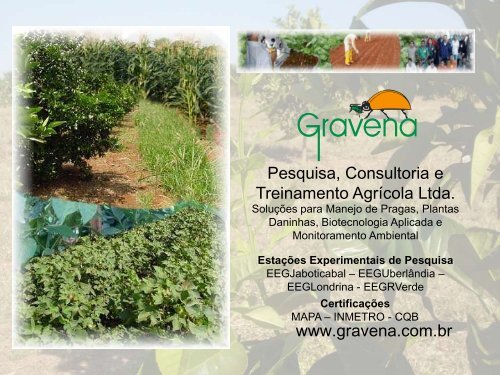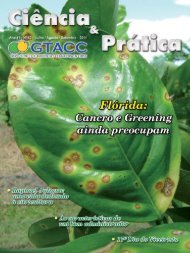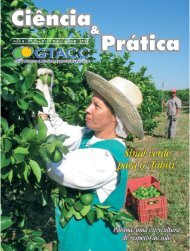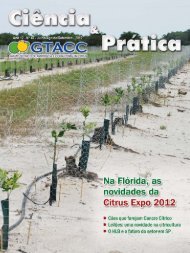Manejo e controle do ácaro da falsa ferrugem dos citros - GTACC
Manejo e controle do ácaro da falsa ferrugem dos citros - GTACC
Manejo e controle do ácaro da falsa ferrugem dos citros - GTACC
Create successful ePaper yourself
Turn your PDF publications into a flip-book with our unique Google optimized e-Paper software.
Pesquisa, Consultoria e<br />
Treinamento Agrícola Lt<strong>da</strong>.<br />
Soluções para <strong>Manejo</strong> de Pragas, Plantas<br />
Daninhas, Biotecnologia Aplica<strong>da</strong> e<br />
Monitoramento Ambiental<br />
Estações Experimentais de Pesquisa<br />
EEGJaboticabal – EEGUberlândia –<br />
EEGLondrina - EEGRVerde<br />
Certificações<br />
MAPA – INMETRO - CQB<br />
www.gravena.com.br
<strong>Manejo</strong> Ecológico de<br />
Ácaro <strong>da</strong> Ferrugem <strong>do</strong>s<br />
Citros<br />
MSc J. Luiz Silva<br />
Prof. Santin Gravena<br />
Dr. Sergio Benvenga<br />
Dr. Renan Gravena<br />
Dra Adriana R. Gravena<br />
Biol. Luiz C. de S. Amorim<br />
Hist. Nilton Araújo Jr.
JABOTICABAL - SP<br />
EEGJ-Estação Experimental <strong>da</strong> Gravena<br />
LONDRINA - PR<br />
EEGL-Estação Experimental <strong>da</strong> Gravena<br />
A Gravena hoje<br />
UBERLÂNDIA - MG<br />
EEGU-Estação Experimental <strong>da</strong> Gravena<br />
RIO VERDE - GO<br />
EEGRV-Estação Experimental <strong>da</strong> Gravena
<strong>Manejo</strong> Ecológico de Ácaro<br />
<strong>da</strong> Ferrugem <strong>do</strong>s Citros<br />
Inspeção <strong>do</strong> Ácaro <strong>da</strong><br />
Ferrugem
Princípios <strong>da</strong> Inspeção<br />
Definin<strong>do</strong> a Área a ser inspeciona<strong>da</strong>:<br />
Tamanho <strong>do</strong> Talhão: Ideal 2000 plantas.<br />
Número de Plantas Inspeciona<strong>da</strong>s/Talhão:<br />
mínimo de 10 plantas ( talhões < 1000<br />
plantas), ou 1% para talhões com mais de<br />
1.000 plantas.<br />
Número de partes a serem inspeciona<strong>da</strong>s<br />
por Planta: de 3 a 4 partes
Caminhamento: deve-se caminhar em Zigue-<br />
Zague, exemplifica<strong>do</strong> em talhão de 2000 plantas
Princípios <strong>da</strong> Inspeção<br />
Intervalo entre as inspeções:<br />
Ideal 7 dias<br />
Padrão 15 dias<br />
Regulari<strong>da</strong>de <strong>da</strong> Inspeção:<br />
Jamais desviar o Inspetor de Pragas para<br />
outras funções, para evitar per<strong>da</strong>s<br />
irreparáveis<br />
Exemplos: calendários adequa<strong>do</strong>s a seguir
Ovos Ninfa I<br />
Biologia <strong>do</strong> Ácaro <strong>da</strong> Ferrugem<br />
2 - 8 dias 1 - 3 dias 1 - 3 dias 14 - 23 dias<br />
Ciclo de Vi<strong>da</strong>: 7 - 14 dias Longevi<strong>da</strong>de<br />
Postura: 1 ovo/dia 20-30 no verão Pré-Oviposição: 1 - 4 dias<br />
Gosta de ficar <strong>do</strong><br />
la<strong>do</strong> <strong>da</strong> fruta<br />
Comportamento<br />
Ninfa II Adulto+Exúvia<br />
Espalha<br />
pelo<br />
Vento
Inspecionan<strong>do</strong><br />
Ácaro <strong>da</strong><br />
Ferrugem<br />
Adultos e Ninfas
Uni<strong>da</strong>de de Amostra<br />
É o local de preferência <strong>do</strong> Ácaro <strong>da</strong> Ferrugem na Planta<br />
Nas frutas verdes <strong>do</strong> ano, na periferia<br />
(fora) <strong>da</strong> copa <strong>da</strong> planta, <strong>do</strong> la<strong>do</strong> <strong>da</strong><br />
fruta, portanto, nem no la<strong>do</strong> que bate o<br />
sol, nem no la<strong>do</strong> de trás onde tem<br />
sombra.
Uma só<br />
lupa<strong>da</strong> <strong>do</strong> la<strong>do</strong><br />
<strong>da</strong> fruta<br />
Amostragem (Inspeção)<br />
Procurar pela uni<strong>da</strong>de de amostra<br />
5 ou<br />
mais<br />
<strong>ácaro</strong>s<br />
Contagem ou<br />
estimativa <strong>do</strong><br />
número de <strong>ácaro</strong>s<br />
encontra<strong>do</strong>s<br />
Densi<strong>da</strong>de Referência<br />
20 ou<br />
mais<br />
<strong>ácaro</strong>s<br />
Anotação <strong>do</strong><br />
número encontra<strong>do</strong><br />
na Ficha de<br />
Inspeção<br />
30 ou<br />
mais<br />
<strong>ácaro</strong>s
Amostragem<br />
Ficha de Inspeção (Modelo Gravena)
Preenchimento <strong>da</strong> ficha, cálculos e<br />
porcentagens finais<br />
DENSIDADES<br />
REFERÊNCIAS<br />
TOTAL DE VISADAS FEITAS<br />
PORCENTAGENS FINAIS
Pica<strong>da</strong> <strong>do</strong> Ácaro <strong>da</strong> Ferrugem
Importância, Danos, Biologia e<br />
Comportamento e MEP:<br />
branco <strong>ferrugem</strong><br />
leprose<br />
purpúreo<br />
Comparação <strong>do</strong>s<br />
<strong>ácaro</strong>s de <strong>citros</strong>–<br />
tamanho (foto real)<br />
Clima:<br />
Purpureoquente e<br />
seco<br />
Leproseindiferente<br />
Ferrugem e Branco<br />
quente e úmi<strong>do</strong>
Tipo de <strong>da</strong>no que causa o Ácaro <strong>da</strong> Ferrugem<br />
ELE GOSTA DE FICAR DO LADO DA FRUTA<br />
ONDE BATE O SOL NÃO TEM ÁCARO
Tipo de <strong>da</strong>no que causa o Ácaro <strong>da</strong> Ferrugem<br />
Na Folha<br />
Na folha também o <strong>ácaro</strong><br />
se estabelece na face de<br />
quase sombra (nem sol<br />
nem sombra), e é onde o<br />
IP deve bater a lupa uma<br />
vez só, como na fruta.
Danos Classificação
Importância <strong>do</strong> Ácaro <strong>da</strong> Ferrugem<br />
Indústria:quan<strong>do</strong> o preço está baixo não aceita fruta<br />
mancha<strong>da</strong>, mas quan<strong>do</strong> o preço está alto manchas leves<br />
não tem importância, manchas severas causam per<strong>da</strong> de<br />
peso e volume mas aumenta sóli<strong>do</strong>s solúveis no suco o que<br />
é desejável pára a indústria.<br />
Merca<strong>do</strong>: o consumi<strong>do</strong>r não aceita laranja com manchas,<br />
portanto, pomares com frutas para ven<strong>da</strong> ao merca<strong>do</strong> de<br />
frutas frescas necessitam um bom manejo <strong>do</strong> <strong>ácaro</strong> <strong>da</strong><br />
<strong>ferrugem</strong>.
Novo Ácaro Marrom <strong>da</strong><br />
Ferrugem <strong>do</strong>s Citros
Ácaro <strong>da</strong> Ferrugem Marrom <strong>do</strong>s Citros<br />
(Citrus Brown Rust Mite)<br />
Tegolophus brunneus Flechtmann<br />
Acari: Eriophyi<strong>da</strong>e
Como surgiu na Citricultura Paulista<br />
1. Descoberto nos anos 90, aparece de novo com maior freqüência<br />
nos pomares de <strong>citros</strong> <strong>do</strong> Esta<strong>do</strong> de S. Paulo e é de difícil<br />
<strong>controle</strong>.<br />
2. O Ácaro Marrom <strong>da</strong> Ferrugem <strong>do</strong>s Citros, Tegolophus<br />
brunneus Flechtmann, foi encontra<strong>do</strong> no Brasil pela primeira<br />
vez em 1999.<br />
3. No mun<strong>do</strong>, ocorrem 57 gêneros deste <strong>ácaro</strong>, atacan<strong>do</strong> diversas<br />
frutíferas e destas 29 estão na China.<br />
4. Nos <strong>citros</strong>, a espécie mais conheci<strong>da</strong> é o Ácaro Marrom <strong>do</strong>s<br />
Citros, Tegolophus australis, que ataca parte <strong>da</strong> citricultura<br />
australiana.
Aspectos <strong>do</strong> Ácaro <strong>da</strong> Ferrugem<br />
Phyllocoptruta oleivora
É branco amarela<strong>do</strong><br />
É mais afila<strong>do</strong> <strong>do</strong> que triangular
Aspectos <strong>do</strong> Ácaro <strong>da</strong> Ferrugem<br />
Phyllocoptruta oleivora
Aspectos <strong>do</strong> Ácaro <strong>da</strong> Ferrugem<br />
Phyllocoptruta oleivora<br />
Ataques<br />
periféricos <strong>da</strong><br />
copa
Tegolophus brunneus<br />
É branco amarela<strong>do</strong>-amarronza<strong>do</strong><br />
É mais triangular <strong>do</strong> que afila<strong>do</strong>
Biologia e Comportamento<br />
Basea<strong>do</strong> no Ácaro Australiano<br />
Tegolophus australis<br />
Surgem mais em regiões úmi<strong>da</strong>s<br />
Não são problemas em regiões secas<br />
Na copa gostam <strong>do</strong> interior (umi<strong>da</strong>de)<br />
Os <strong>da</strong>nos são uniformes devi<strong>do</strong> sombra<br />
Qualquer i<strong>da</strong>de de fruta (?)
Ácaro <strong>da</strong> Ferrugem Marrom <strong>do</strong>s Citros<br />
Tegolophus australis
Tegolophus<br />
brunneus<br />
comparan<strong>do</strong><br />
Phyllocoptruta<br />
oleivora<br />
´Ferrugem Marrom ´Ferrugem Amarelo
Danos<br />
Ácaro <strong>da</strong> Ferrugem Marrom <strong>do</strong>s Citros<br />
Tegolophus australis
Danos<br />
Ácaro <strong>da</strong> Ferrugem Marrom <strong>do</strong>s Citros<br />
Tegolophus brunneus
Controle <strong>do</strong> Ácaro <strong>da</strong><br />
Ferrugem <strong>do</strong>s Citros
Fases <strong>do</strong> Ciclo de Vi<strong>da</strong><br />
Ovos Ninfa I Ninfa II Adulto+Exúvia<br />
Aspectos Biológicos (Verão e Inverno)<br />
2 - 8 dias 1 - 3 dias 1 - 3 dias 14 - 23 dias<br />
Ciclo de Vi<strong>da</strong>: 7 - 14 dias Longevi<strong>da</strong>de<br />
Fecundi<strong>da</strong>de: 1 ovo/dia 20-30 no<br />
verão<br />
Perío<strong>do</strong> Pré-Oviposição: 1 - 4 dias
Desenvolvimento <strong>do</strong> Ácaro <strong>da</strong> Ferrugem<br />
Perío<strong>do</strong> de Incubação<br />
8<br />
7<br />
6 5 4 3 2 1<br />
Pulverização<br />
30 ºC<br />
Perio<strong>do</strong> de Eclosão de Ovos<br />
1 2 3 4 5 6 7 8<br />
Eclosão de Ovos até 02<br />
dias depois <strong>da</strong> Aplicação
Desenvolvimento <strong>do</strong> Ácaro <strong>da</strong> Ferrugem<br />
Perío<strong>do</strong> de Incubação<br />
8<br />
7<br />
6 5 4 3 2 1<br />
Pulverização<br />
25ºC<br />
Perio<strong>do</strong> de Eclosão de Ovos<br />
1 2 3 4 5 6 7 8<br />
Eclosão de Ovos até 04<br />
dias depois <strong>da</strong> Aplicação
Desenvolvimento <strong>do</strong> Ácaro <strong>da</strong> Ferrugem<br />
Perío<strong>do</strong> de Incubação<br />
8<br />
7<br />
6 5 4 3 2 1<br />
Pulverização<br />
20ºC<br />
Perio<strong>do</strong> de Eclosão de Ovos<br />
1 2 3 4 5 6 7 8<br />
Eclosão de Ovos até 08<br />
dias depois <strong>da</strong> Aplicação
Marcas<br />
Comerciais de<br />
Enxofre<br />
Resulta<strong>do</strong>s de Laboratório<br />
Dosagem/2000 L<br />
Eficiência (%)<br />
1- Kumulus 5,0 Kg 95%<br />
2- Thiovit 5,0 Kg 94%<br />
3- Sulfur 800 5,0 Kg 88%<br />
4- Agrothio 800 5,0 L 90%<br />
5- Monitor 5,0 Kg 84%
Marcas<br />
Comerciais de<br />
Enxofre<br />
Resulta<strong>do</strong>s de Laboratório<br />
Dosagem/2000 L<br />
Eficiência (%)<br />
1- Kumulus 10,0 Kg 100%<br />
2- Thiovit 10,0 Kg 100%<br />
3- Sulfur 800 10,0 Kg 96%<br />
4- Agrothio 800 10,0 L 97%<br />
5- Monitor 10,0 Kg 94%
Marcas<br />
Comerciais de<br />
Enxofre<br />
Resulta<strong>do</strong>s de Campo<br />
Dosagem/2000 L<br />
Eficiência (%)<br />
1- Kumulus 5,0 Kg 91%<br />
2- Thiovit 5,0 Kg 90%<br />
3- Sulfur 800 5,0 Kg 83%<br />
4- Agrothio 800 5,0 L 85%<br />
5- Monitor 5,0 Kg 78%
Marcas<br />
Comerciais de<br />
Enxofre<br />
Resulta<strong>do</strong>s de Campo<br />
Dosagem/2000 L<br />
Eficiência (%)<br />
1- Kumulus 10,0 Kg 95%<br />
2- Thiovit 10,0 Kg 95%<br />
3- Sulfur 800 10,0 Kg 89%<br />
4- Agrothio 800 10,0 L 90%<br />
5- Monitor 10,0 Kg 85%
1 <strong>ácaro</strong><br />
1 <strong>ácaro</strong><br />
Potencial Biótico<br />
5-7 dias Dá origem a 20<br />
<strong>ácaro</strong>s<br />
> 25°C<br />
25-30 dias<br />
> 25°C<br />
Dá origem a<br />
3.200.000<br />
<strong>ácaro</strong>s
Campo Demonstrativo de All Spray Master<br />
em mistura com Vertimec 18 EC em<br />
comparação com a mistura com Natur’Oil<br />
(óleo vegetal) no manejo <strong>do</strong> Ácaro <strong>da</strong><br />
Ferrugem em <strong>citros</strong>.<br />
Santin Gravena<br />
Renan Gravena<br />
José Luiz Silva<br />
Sérgio Benvenga<br />
Luís Carlos de Souza Amorim<br />
Vlader Cordioli<br />
Marcelo Tadeu Fardini <strong>da</strong> Silva
All Spray Master no <strong>Manejo</strong> <strong>do</strong> Ácaro <strong>da</strong><br />
Ferrugem em Citros<br />
Produtos, princípios ativos e <strong>do</strong>ses testa<strong>da</strong>s no manejo <strong>do</strong> <strong>ácaro</strong> <strong>da</strong> <strong>ferrugem</strong> em frutos, na cultura <strong>do</strong>s<br />
<strong>citros</strong>. Jaboticabal, SP, 2008.<br />
Acarici<strong>da</strong> Ingrediente Ativo<br />
Dose<br />
mL p.c./100 L L p.c. / 2000 L<br />
Vertimec 18 EC + All Spray<br />
Master<br />
abamectina + resina orgânica 20,0 + 10,0 0,4 + 0,2<br />
Vertimec 18 EC + Natur’Oil abamectina + óleo vegetal 20,0 + 250 0,4 + 5,0<br />
Testemunha - - - - - - - - -
Efeito de Abamectina sobre Ácaro <strong>da</strong> Ferrugem<br />
no Fruto Verde<br />
Fenologia<br />
Fruto<br />
Folha
% Eficiência<br />
All Spray Master no <strong>Manejo</strong> <strong>do</strong> Ácaro <strong>da</strong><br />
100<br />
90<br />
80<br />
70<br />
60<br />
50<br />
40<br />
30<br />
20<br />
10<br />
0<br />
Ferrugem em Citros<br />
Eficiência de Vertimec 18 EC + All Spray Master, no <strong>Manejo</strong> <strong>do</strong> Ácaro <strong>da</strong> Ferrugem, em Frutos<br />
verdes de <strong>citros</strong>.<br />
4 7 10 14 21 28 35 42 49<br />
Dias Após o Tratamento<br />
Vertimec + All Spray Máster 20,0 + 10,0 mL/100L<br />
Vertimec + Natur’Oil 20,0 + 250 mL/100L
Efeito de Abamectina sobre Ácaro <strong>da</strong> Ferrugem<br />
Fruto Maduro
% Eficiência<br />
All Spray Master no <strong>Manejo</strong> <strong>do</strong> Ácaro <strong>da</strong><br />
100<br />
90<br />
80<br />
70<br />
60<br />
50<br />
40<br />
30<br />
20<br />
10<br />
0<br />
Ferrugem em Citros<br />
Eficiência de Vertimec 18 EC + All Spray Master, no <strong>Manejo</strong> <strong>do</strong> Ácaro <strong>da</strong> Ferrugem, em Frutos<br />
Maduros de <strong>citros</strong>.<br />
4 7 10 14 21 28 35 42 49<br />
Dias Após o Tratamento<br />
Vertimec + All Spray Máster 20,0 + 10,0 mL/100L<br />
Vertimec + Natur’Oil 20,0 + 250 mL/100L
Piretróides<br />
Decis<br />
Fastac<br />
Karatê<br />
Nexide<br />
Aumenta<br />
Controle <strong>do</strong> Psilídeo em Citros<br />
Fosfora<strong>do</strong>s<br />
Dimetoato<br />
Supracid/<br />
Suprathion<br />
Cefanol/<br />
Orthene<br />
Clorpirifós<br />
Diminui<br />
<strong>Manejo</strong> de Resistência de Insetici<strong>da</strong>s<br />
Tendência sobre a População de Ácaros<br />
Fisiológicos<br />
Tiger<br />
Applaud<br />
Micromite<br />
Diminui<br />
Grupos Químicos<br />
Éter<br />
Difenílico<br />
Trebon<br />
Sem<br />
Influência<br />
Piretróid.<br />
Acarici<strong>da</strong><br />
Talstar<br />
Meothrin<br />
Danimen<br />
Rufast<br />
Diminui<br />
Neonico-<br />
tinóides<br />
Prova<strong>do</strong><br />
Actara<br />
Convence<br />
Aumenta<br />
Carbamatos<br />
Marshal<br />
Temik<br />
Diminui
Para se ter um bom Controle <strong>do</strong> Ácaro <strong>da</strong><br />
Ferrugem <strong>do</strong>s Citros devemos:<br />
1- Inspecionar e controlar o <strong>ácaro</strong> <strong>da</strong><br />
<strong>ferrugem</strong> de acor<strong>do</strong> com o nível de <strong>controle</strong>.<br />
2- Conhecer melhor o <strong>ácaro</strong> <strong>da</strong> <strong>ferrugem</strong>.<br />
3- Saber as características <strong>do</strong>s acarici<strong>da</strong>s que<br />
serão usa<strong>do</strong>s no <strong>controle</strong> <strong>do</strong> <strong>ácaro</strong> <strong>da</strong><br />
<strong>ferrugem</strong>.
EG-ESTAÇÕES<br />
Jaboticabal<br />
EXPERIMENTAIS DE<br />
Uberlândia<br />
PESQUISA DA GRAVENA<br />
Londrina<br />
Rolandia<br />
Sede<br />
Rolândia<br />
EEGJ<br />
Sede<br />
EEGL<br />
EEGU<br />
CEFET<br />
Ain<strong>da</strong> reestruturan<strong>do</strong><br />
Sede
Venham nos visitar!






